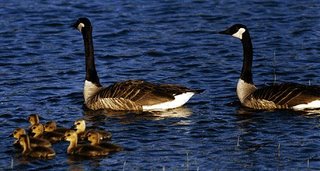Sunday, July 02, 2006
Here's more
Anything that helps an organism survive in its environment is an adaptation. It also refers to the ability of living things to adjust to different conditions within their environments.
Structural Adaptations.
Involves some part of an animal's body, such as the size or shape of the teeth, the animal's body covering, or the way the animal moves.
 Teeth - since different animals eat different things, they don't all have the same kind of teeth
Teeth - since different animals eat different things, they don't all have the same kind of teethBody coverings - Hair, scales, spines, and feathers grow from the skin. All of these parts help animals survive in their environments.
Movement - animals find food by moving from place to place

Camouflage.
Protective coloration and protective resemblance allow an animal to blend into its environment. Their camouflage makes it hard for enemies to single out individuals.
Mimicry
Allows one animal to look, sound, or act like another animal to fool predators into thinking it is poisonous or dangerous.
Behaviour Adaptations
Include activities that help an animal survive. Behavior adaptations can be learned or instinctive. (a behaviour an animal is born with).
Social behavior - some animals live by themselves, while other live in groups.
Behaviour for protection - An animal's behavior sometimes helps to protect the animal. For instance the opossum plays dead. A rabbit freezes when it thinks it has been seen.
 Migration-is the behavioral adaptation that involves an animal or group of animals moving from one region to another and then back again.
Migration-is the behavioral adaptation that involves an animal or group of animals moving from one region to another and then back again.Animals migrate for different reasons. The reasons are as follows.
-better climate
-better food
-safe place to live
-safe place to raise young
-go back to the place they were born.
 Hibernation
HibernationA deep sleep in which an animal's body temperature drops to about the temperature of the environment. Body activities, such as heartbeat and breathing are slowed causing the animal to need very little food.
Animals that hibernate are bats,woodchucks,snakes,bears.
During the hibernation the animals live off of the fat that is stored in their body.

Haha...just for entertainment...but it may be show on the tv screen if my show is sucessfull =)
Saturday, July 01, 2006
Ok… Dear People… maybe this will help if you are doing project on adaptation =) Adapted from: http://www.gma.org/surfing/antarctica/penguin.html I am sort of doing this project too…surfing the net…=)


Here is a sketch of all kinds of penguins
Penguins are designed for life in the sea. Some species spend as much as 75% of their lives in the water. (They lay their eggs and to raise their chicks on land.) Heavy, solid bones act like a diver's weight belt, allowing them to stay underwater. Their wings, shaped like flippers, help them "fly" underwater at speeds up to 15 mph. A streamlined body, paddle-like feet, insulating blubber, and watertight feathers all add to their efficiency and comfort underwater. They also have a remarkable deep-diving ability.
In addition to blubber for insulating warmth, penguins have stiff, tightly packed feathers (up to 70 per sq. in.) that overlap to provide waterproofing. They coat their feathers with oil from a gland near the tail to increase impermeability. Black and white countershading makes them nearly invisible to predators from above and below.
Like most birds, penguins have little or no sense of smell (a boon for those in a crowded penguin rookery!) Like other birds, their sense of taste is also limited. Their vision appears to be better when they are underwater. Scientists suspect they may be nearsighted on land.
Penguins are considered to be the most social of birds. Rookeries may contain thousands of individuals. (As many as 24 million penguins visit the Antarctic continent!) Even at sea, they tend to swim and feed in groups.
Most species of penguins build nests, but the nests may consist only of a pile of rocks or scrapings or hollows in the dirt. Emperor penguins build no nests; they hold the egg on top of their feet under a loose fold of skin called the brood patch.

Hi people ! Welcome to my blog ! I’m just a primary school girl who lurves to collect bears .My e-mail is starrial_teong@hotmail.com e-mail me if u have comments or just type your comments in the tag box =)THX!
